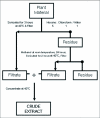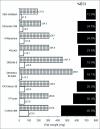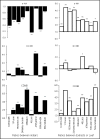Response of the cutworm Spodoptera litura to sesame leaves or crude extracts in diet
- PMID: 20050772
- PMCID: PMC3011954
- DOI: 10.1673/031.009.5201
Response of the cutworm Spodoptera litura to sesame leaves or crude extracts in diet
Abstract
The effects of extracts of sesame, Sesamum indicum L. (Liamiales: Pedaliaceae), and whole leaves of some selected cultivars of sesame were tested using a natural host Spodoptera litura (F.) (Lepidoptera: Noctuidae). Indices taken using the immature stages include; diet utilization, growth and development and induction of detoxification enzymes. The results indicate that S. litura generally selects its food amongst cultivars within 6 hours after food presentation. Growth and development of the insect is controlled also by plant acceptability and quality. Although all the cultivars tested significantly limit insect growth and development the variety 56S-radiatum did not allow a complete life cycle as pupation from first instar stage was 0%. Generally the crucial period for immature S. litura was the larval period, especially the first two instars where the weight of an insect fed on an experimental diet was three times lower than that of a control diet. The larval developmental period was greater than 40 days as compared to 17 days for insects fed a control diet. S. litura also had lowered efficiency in utilizing ingested food, from a low of 13% in a sesame cultivar to 45% in the control diet. The key detoxification enzyme was a glutathione s-transferase that was confirmed by a 6-fold increase between S. litura fed a plant cultivar vs. a control diet towards the substrate 1,2-dichloro-4-nitrobenzene. First and second instars of S. litura have a relatively reduced detoxification of enzymes in response to plant cultivar diets leading to low survival. A 3% v/w crude extract of the cultivars increased enzyme induction towards all the tested substrates.
Figures




Similar articles
-
Accumulation and excretion of zinc and their effects on growth and food utilization of Spodoptera litura (Lepidoptera: Noctuidae).Ecotoxicol Environ Saf. 2020 Oct 1;202:110883. doi: 10.1016/j.ecoenv.2020.110883. Epub 2020 Jun 20. Ecotoxicol Environ Saf. 2020. PMID: 32570104
-
Pepper feeding derivative Brucella sp. in the gut of Spodoptera litura (Lepidoptera: Noctuidae) affect the growth and development of host larvae.Pestic Biochem Physiol. 2025 Apr;209:106332. doi: 10.1016/j.pestbp.2025.106332. Epub 2025 Feb 16. Pestic Biochem Physiol. 2025. PMID: 40082029
-
Effect of sesame leaf diet on detoxification activities of insects with different feeding behavior.Arch Insect Biochem Physiol. 2012 Nov;81(3):148-59. doi: 10.1002/arch.21045. Epub 2012 Aug 10. Arch Insect Biochem Physiol. 2012. PMID: 22886908
-
Growth Performance and Biometric Characteristics of Spodoptera litura (Lepidoptera: Noctuidae) Reared on Different Host Plants.J Econ Entomol. 2015 Oct;108(5):2242-9. doi: 10.1093/jee/tov192. Epub 2015 Jul 9. J Econ Entomol. 2015. PMID: 26453712
-
Glutathione S-transferase SlGSTE1 in Spodoptera litura may be associated with feeding adaptation of host plants.Insect Biochem Mol Biol. 2016 Mar;70:32-43. doi: 10.1016/j.ibmb.2015.10.005. Epub 2015 Nov 26. Insect Biochem Mol Biol. 2016. PMID: 26631599
Cited by
-
Development and Leaf Consumption by Spodoptera cosmioides (Walker) (Lepidoptera: Noctuidae) Reared on Leaves of Agroenergy Crops.Neotrop Entomol. 2013 Dec;42(6):588-94. doi: 10.1007/s13744-013-0169-6. Epub 2013 Sep 20. Neotrop Entomol. 2013. PMID: 27193276
-
Effects of botanical pesticide itol A against the tobacco cutworm, Spodoptera litura (Fab.).Environ Sci Pollut Res Int. 2020 Apr;27(11):12181-12191. doi: 10.1007/s11356-020-07824-2. Epub 2020 Jan 27. Environ Sci Pollut Res Int. 2020. PMID: 31989496
-
Efficacy of sub lethal concentration of entomopathogenic fungi on the feeding and reproduction of Spodoptera litura.Springerplus. 2015 Nov 6;4:681. doi: 10.1186/s40064-015-1437-1. eCollection 2015. Springerplus. 2015. PMID: 26558183 Free PMC article.
-
Effect of Tannic Acid on Nutrition and Activities of Detoxification Enzymes and Acetylcholinesterase of the Fall Webworm (Lepidoptera: Arctiidae).J Insect Sci. 2020 Jan 1;20(1):8. doi: 10.1093/jisesa/ieaa001. J Insect Sci. 2020. PMID: 32061083 Free PMC article.
References
-
- Abdel Rahman KM. Food consumption and utilization of the grasshopper Chrotogonus lugubris Blanchard (Orthoptera, Acridoidea, Pyrgomorphidae) and its effect on the egg deposition. Journal of Central European Agriculture. 2001;2:263–270.
-
- Ahmad S, Brattsten LB, Mullin CA, Yu SJ. Enzymes involved in the metabolism of plant allelochemicals. In: Brattsten LB, Ahmad S, editors. Molecular aspects of insect-plant associations. Plenum Press; 1986. pp. 73–151.
-
- Ayres DC, Loike JD. Lignons Chemical, biological and clinical properties. Cambridge University Press; 1990.
-
- Berenbaum MR. Post genomic chemical ecology: from genetic code to ecological interactions. Journal of Chemical Ecology. 2002;28:873–895. - PubMed
MeSH terms
Substances
LinkOut - more resources
Full Text Sources

